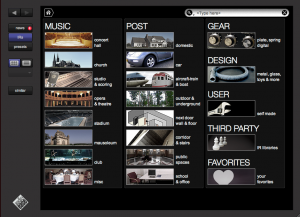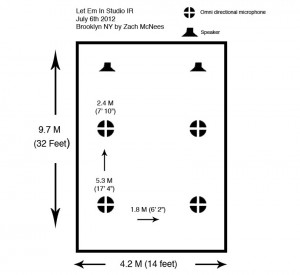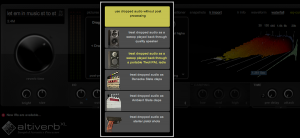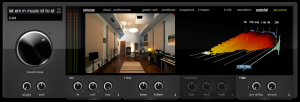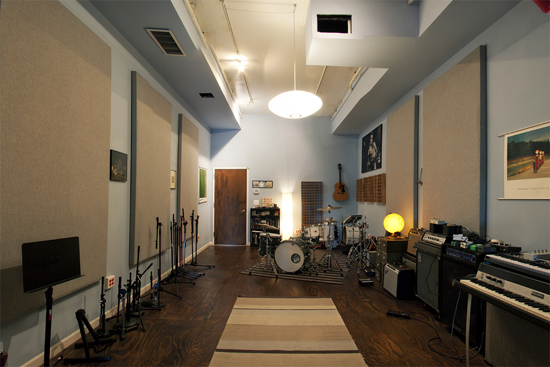The Brooklyn Studio Sounds: An Altiverb Impulse Response Project, Part I – Let ‘Em In Music
I came to New York City nine years ago from Boston to work at The Hit Factory. The experience of working as an assistant engineer there during the last years that the studio was open was a time in my life and my career that I’ll never forget. The studio was famous for many reasons, but above all, The Hit Factory laid claim to some of the most beautiful and acoustically pristine recording rooms in the world.
When the studio closed in 2005, the music and recording world lost a treasure that will never be replicated. The sound of the studio now exists only on the records of artists like Michael Jackson, Whitney Houston, Bruce Springsteen and many more.
Over the past decade, with advancements in digital audio technology, it’s become possible to recreate real-world acoustic spaces inside the box thanks to convolution style reverb plug-ins, presets and patches derived from impulse responses created by sampling actual rooms. One of the most popular and well-known convolution reverbs on the market is Altiverb, made by the Dutch software company Audio Ease.
In Altiverb, Audio Ease has implemented proprietary technology for capturing the sound of a room by playing back proprietary “blips” and sweep tones and recording the information. These recordings are then processed and turned into impulse responses of the room to be used like a plugin on a session.
The result is a stunning replication of the room that is so close to the original, that the difference between the reference audio recorded in the room and the same dry audio played back through the impulse response of the room in Altiverb are nearly imperceptible.
The latest version of Altiverb (version 7) has made the process even simpler. Altiverb users can now download the sweep files, record them in a room and drag the recordings directly into Altiverb to create and save their own impulse responses immediately.
Because Altiverb is such an amazing tool for capturing the sound of a room, we now have the ability to preserve the sound of any recording studio or unique acoustic space fairly easily. Of course there’s no substitution for actually recording in the original space, but having a representation of the room sound in plug-in form – especially if the room no longer exists – is a nice option, and a really cool addition to the sonic palette.
Capturing The Sounds of Brooklyn
With Altiverb 7 on my laptop, I decided to start a project aimed at capturing the sounds of Brooklyn recording studios as acoustic spaces.
Beyond just sampling these sounds for my own use, I thought it would be a worthy endeavor to showcase some of the new wave of recording studios in Brooklyn for the rest of the world through Altiverb, while simultaneously documenting a historical record of the sound of these rooms to further enhance that experience. Audio Ease has agreed to make the impulse responses I’ve created available on their website for download and use for owners of Altiverb 7. The first IR I captured, of Let ‘Em In Studios (see below), is available to Altiverb 7 users now.
Before we visit Let ‘Em In, let’s take a look at the process of capturing an impulse response:
At each studio I visited, I captured both stereo-to-stereo and mono-to-stereo impulse responses. The process of capturing the impulse response of a room is relatively simple but very precise. The basic idea is to setup a pair of good quality studio monitor speakers on stands in a spot in the room where a loud instrument like a drum kit might normally be positioned and point them directly at the capsules of a spaced pair of microphones on the opposite side of the room. Omnidirectional mics are usually best as they will capture the ambience of a room most naturally; I used a pair of AKG 414 B-ULSs.
Precise measurements were taken to make sure the distances were exact between the speaker tweeter and microphone capsule and between each speaker and mic for both the left and right side. Once we were setup, I played back and recorded some reference audio of dry drums, percussion and double bass for each setup so that I could A/B the sound of the room versus the impulse response created by Altiverb later.
After the reference audio was recorded, we then began capturing the impulse responses by playing back the blip and sweep tone. Altiverb requires four channels of audio for a stereo-to-stereo impulse response and two channels for a mono-to-stereo response. The four channels are derived from recording a stereo set listening to the left channel individually and then repeating the process listening to the right speaker individually. Once the stereo-to-stereo IR was captured, we would then move one speaker to the center position exactly between the two microphones and repeat the reference audio recording and then sweep tone.
For some rooms, we recorded multiple IRs at varying distances. Each distance will end up being a separate impulse response that can be used inside Altiverb. This gives the end user the ability to decide which mic placement in the room sounds best for their mix.
Once the sweep tones have been recorded, they can be dragged directly into Altiverb via the IR Import tab. Altiverb allows for a few different type of playback devices such as a “quality” speaker, a Tivoli PAL radio, a slate clap or a starter pistol. For full-range music production quality Impulse Responses, a quality speaker is highly recommended. The other modes of capture are more than adequate for film and post-production applications to be used when mixing or replacing dialogue.
For each studio in this series, I will provide a few different audio examples showcasing the difference between the actual audio recorded by the mics in the room vs. the same dry audio played through the Altiverb impulse response of the room. I will also provide a commercially available track recorded at each studio.
On the whole, most mix engineers would probably agree that they don’t do a whole lot of EQ or compression on the outputs of their reverbs. One interesting thing I’ve discovered in working with Altiverb and creating these new impulse responses is, Altiverb’s algorithm is so accurate to the original sound that I find it’s often necessary and quite helpful to treat the output of Altiverb with EQ and compression as if it were just another pair of mics recorded live with your session.
Let’s have a look and listen to the first studio I visited! I will continue this virtual Brooklyn studio tour in the next few parts of this series:
Let Em’ In Music – 540 President Street (Gowanus, Brooklyn)
Let Em’ In Music opened in 2009 and is owned and operated by producer/engineer Nadim Issa. Nadim is an admitted late bloomer into the recording community having studied economics in college and working briefly as a banker. “I was miserable there,” said Nadim. “I decided I needed to do what I loved and enrolled in NYU’s music technology graduate program.”
Home recording and an internship at The Doghouse Studio in Park Slope eventually led to what is now Let Em In Music in nearby Gowanus.
I was introduced to Let Em In by fellow SonicScoop writer Justin Colletti shortly after I moved to the Park Slope. Nadim designed the space himself with help from Chris Harmaty and Joe Salvatto providing HVAC and acoustic paneling respectively.
“I wanted a big live room and a comfortable control room that didn’t feel cramped,” said Nadim about his search for a space to rent. The studio is a long rectangular shaped 30 x 13 ft. room with a 12 ft. ceiling. The sound is explosive. Coupled with two of the most beautiful drum kits I’ve ever recorded (Yamaha 82’ recording custom and Ludwig 68’ kit), Let Em’ In has become one of my favorite rooms to work out of in New York City.
When processed through Altiverb, Let Em’ In clocks in at 1.2 seconds of reverb decay. The flat impulse response of the room is fairly dark with a reasonable amount of low-mid range. Overall, the room has a wonderfully vintage woody sound to it that lends itself very well to everything from drums and acoustic guitars to vocals and piano.
Let Em’ In has hosted sessions for artists such as Dinowalrus, Sharon Van Etten, Lady Lamb the Beekeeper and Julia Nunes. Nadim is currently completing mixes for Lady Lamb’s debut full-length album, which was tracked and mixed entirely at the studio.
Here are the sounds of Let Em In Music:
Recorded July 6th 20120 via:
Apple MacBook Pro
Pro Tools 10 + Altiverb 7
I/O – Apogee Duet 2
Monitors – Dynaudio BM5A
Microphones – AKG 414 B-ULS (graciously provided by Justin Colletti)
1) Dry Drums – Drums played back in the room – Dry drums through Altiverb IR
2) Dry Congas – Congas played back in the room – Dry congas through Altiverb IR
3) Horns Dry – Horns Altiverb IR
4) Dry Drums blended with processed Altiverb IR (EQ/Compression)
Listen to a sample music track, recorded at Let ‘Em In:
Eon Contemporary Orchestra – Kashmir (Led Zeppelin)
Engineered and Mixed at Let Em In’ Music by Nadim Issa
Strings: Eon Contemporary Orchestra (ECO)
Arrangement by Gabe Lefkowitz
Vocals: Danny Musengo
Drums: Walker Adams
Zach McNees is a Brooklyn-based producer/engineer/mixer and live recordist who’s worked with Björk, Rob Thomas, Julia Nunes, The Gregory Brothers, Pixies, Liars and Alice Cooper. Get in touch with Zach via http://www.zachmcnees.com.
Audio player for tracks 1-4 from above + Eon Contemporary Orchestra’s rendition of “Kashmir”, in order below…
Please note: When you buy products through links on this page, we may earn an affiliate commission.







